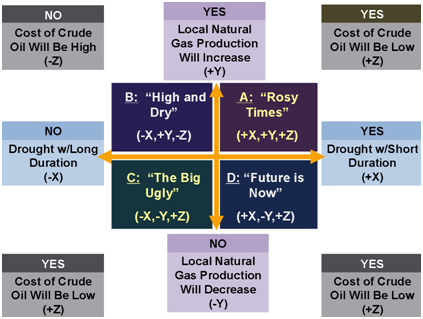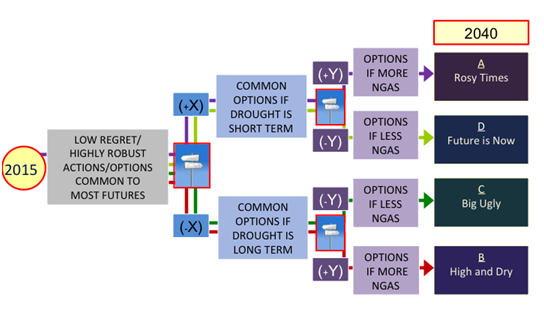Drought, Economic Uncertainty, and Regional Resilience
Time frame: 2015 – 2018 | Client: Southwest Colorado Council of Governments
Background/Context: The SWCOG represents multiple jurisdictions within five counties in southwest Colorado, a mountainous area that is geographically isolated from the rest of the state. Prior to the 1950s, the region relied on agriculture, forestry, and mineral extraction to fuel its economic engine. However, the once booming mineral-extraction and lumber industries subsequently busted with no signs of revival. Family farming is in long-term decline and natural gas production, which partly subsidizes governmental services, is winding down as accessible reserves are being depleted. Because of the region’s stunning views and outdoor amenities, all-season tourism and the second-home real estate market have become key sectors.
The Problem: Climate has become a potential factor further complicating the region’s economic planning environment. In 2015, southwest Colorado was in its fifteenth year of an extended drought, marked by warmer temperatures and smaller snow packs in most years. These conditions in turn resulted in reduced stream flows, more frequent wildfires, and more insect-damaged forest acreage. It was unclear at the time whether the drought would soon end or if it was the front end of a longer-term climatic event. Local entrepreneurs who rely on tourism were concerned that climate-related impacts such as increased frequency of wildfire, hazier skies, denuded slopes, occasional high-magnitude rainstorms and floods, and landslides along transit corridors could threaten the viability of their businesses. There were also concerns that the region could become a less attractive place to live and visit. The strategic issue confronting the region was how to develop a more adaptable and resilient economy given the vulnerability of its economic sectors coupled with the possibility of extended long-term drought.
Working Toward a Solution: The 25-year planning period extended through 2040. Using stakeholder interviews and workshops with representatives from key economic sectors, agencies, and elected officials, three critical planning uncertainties were identified. First, will the future duration of the ongoing drought be short? The question focuses on whether the drought could extend through much of the 25-year planning period and possibly beyond. Second, will local natural gas production increase, providing employment and energy-derived revenues to support services in the region? If new extraction technologies make previously untapped reserves more commercially accessible, then local production could increase, depending on market conditions. Conversely, if reserves remain inaccessible, production will continue to decrease and the ancillary businesses which directly and indirectly rely on mineral extraction will suffer. And third, will the unit cost of globally-priced crude oil stay relatively low through 2040? Given the area’s economic dependence on tourism, the cost of gasoline and jet fuel will likely impact the numbers and types of visitors and how they will spend money while visiting the region. In addition, gasoline costs would impact the profit margin and competitiveness of agricultural products and goods produced in the area since the fuel cost of transporting products to distant markets would increase.
These uncertainties were used to develop a matrix of eight hypothetical scenarios or planning futures that collectively defined the range of future possibility with regard to the strategic issue. However, eight futures were deemed excessive given the exploratory nature of the study. Therefore, the planning team reduced these to the four scenarios (A, B, C, and D) shown below:

Each scenario, named by the participants, represents a unique combination of three uncertain “Yes/No” outcomes. These outcomes serve as primary movers of many secondary drivers that collectively define the range of possible planning environments in 2040. Participants explored the challenges and opportunities presented by each of the scenario futures and identified possible actionable options to address the potential emerging conditions of each. Some actions were common to most futures — the “low-regret / highly robust” options that could be applied in the near term. “Contingent” action sets would be relevant at “tipping” points or junctions later in time when forces and influences will drive events toward one set of futures or another. These junctions would be where the SWCOG would reconsider already prepositioned options and make actionable recommendations for its member jurisdictions.

As of 2018, the four scenario futures remain viable. The flow chart will continue to serve as a Map of Possible Futures given the identified strategic issue. The SWCOG can periodically review the scenario assumptions and modify the prepositioned actionable option sets as needed to ensure that this forward-looking, multiple-future perspective continues to have currency.

